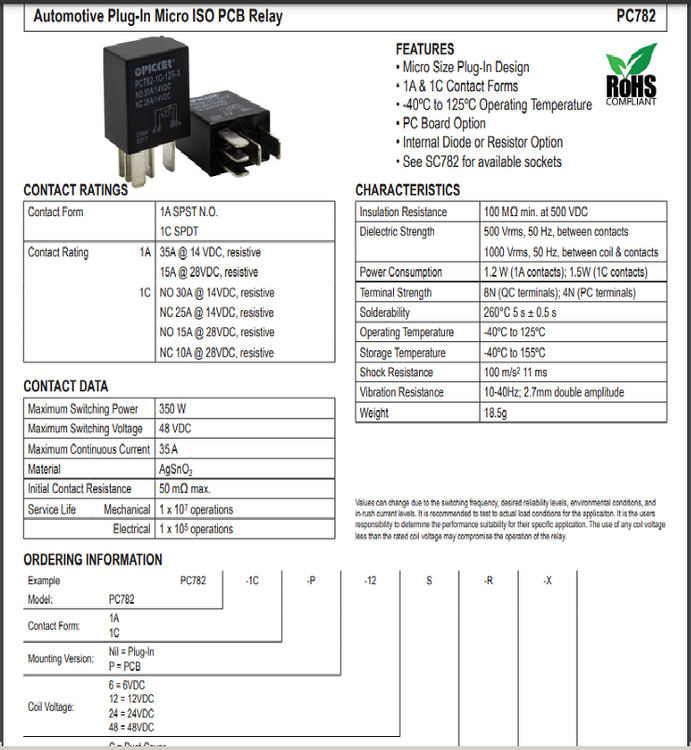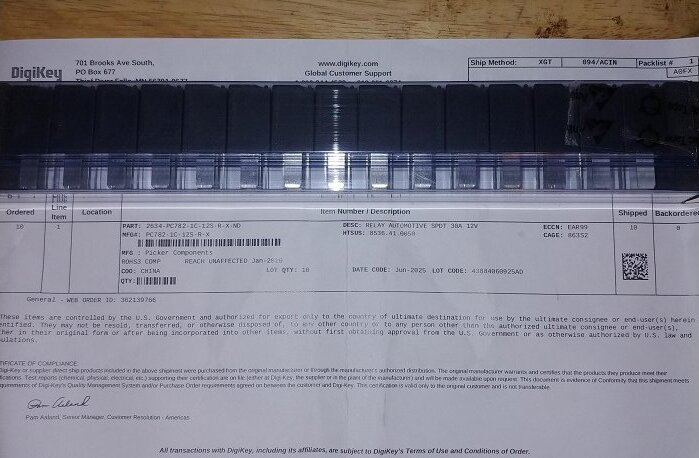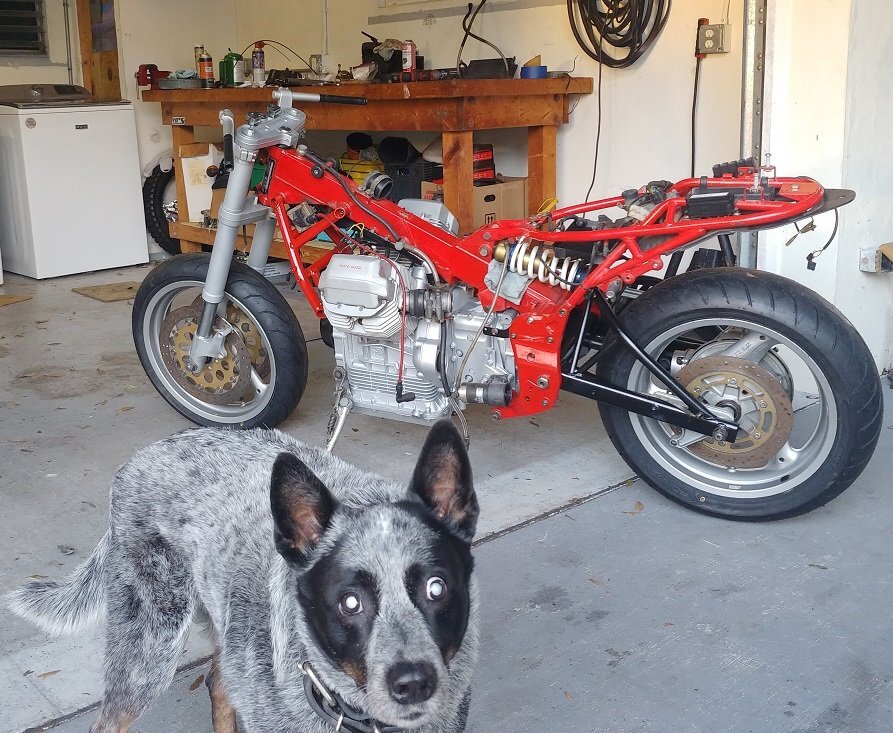-
Posts
1,752 -
Joined
-
Last visited
-
Days Won
76
Content Type
Profiles
Forums
Events
Gallery
Community Map
Everything posted by Pressureangle
-
Nice, this was sorta in my head as where I was going with it. On my BMW I ran the 'tender plug up to the handlebars to power my Garmin as well.
-

Spinning on the starter - wont kick over
Pressureangle replied to bentombed's topic in Technical Topics
Should come with o-ring; be sure you keep track of the shims under the stock one. Fit the two together upside-down to be certain they're the same length, if so send it. Or you can measure the reluctor clearance any number of ways, digital caliper, depth micrometer, home-made tool. -

Spinning on the starter - wont kick over
Pressureangle replied to bentombed's topic in Technical Topics
I forget there are people who don't do F. Fahrfegnugen. -

Spinning on the starter - wont kick over
Pressureangle replied to bentombed's topic in Technical Topics
All inductive sensors operate on the same principle- they're just tiny generators. They are a tight coil, just like the primary side of an ignition coil. When the reluctor tooth passes the tip, it generates a voltage; when the tip passes, it generates an opposite voltage. So the two tests for any inductive sensor are Ohms and AC voltage. Ohms differ between sensors; you have to know the nominal value to test. AC voltage is simple, just connect a DMM (preferably RMS) and read the AC voltage. At very low RPM they output low voltage, which rises with speed. Where the problem with this specific sensor comes, is they break down over time with heat cycles, and the common experience is intermittent poor running/stalling which worsens over time. Works when cold, quits when warm, worsening with cycles. The coil inside open circuits as it swells from heat, so testing ohms while heating is the answer. Testing my failed sensor proved exactly what I saw in the symptoms; failure right as the motor warmed up. I measured consistent open failure at about 150* (edit, 170,) warm enough to be uncomfortable to a hand. And yes, it was swelled in the middle enough to make it worrisome to pull out. -
The torque I quoted is for 12.9 grade bolts- your lower value is probably for 10 grade or so. FWIW the factory bolts are 12.9 grade. The yokes are quite tough and my replacement bolts have a couple threads out beyond the yoke, so I had no fear torquing them to bolt spec (from memory, obviously I'm a little high at 46nm) What is the actual MG service spec for the yoke bolt torque?
-
-
First I'd try cleaning the connection at the fuel pump plug- it may be 'tug testing' when you bang near it. Also possible that the FP relay is marginal for carrying sufficient current-swap it out with the headlight relay to see if that resolves the issue.
-

Spinning on the starter - wont kick over
Pressureangle replied to bentombed's topic in Technical Topics
Not so cheap in the U.S. I have purchased mine from Romania on eBay. It seems they're a common part on many Fiat/Lada but nothing that was ever sold in the Western hemisphere. -
I just torqued mine to 34 lbs-ft, which equals 46 nm. By the book, an 8mm bolt @ 12.9 tensile torques to 31 lbs-ft or 43nm. Torque each separately in steps, 25-30-35-40-43 to be sure the yoke isn't twisted more than necessary during the process. @docc the bolts are 8mm x 1.25 thread.
-
So it is, and quite obviously in Docc's broken yoke. Missed that.
-
Yes, for whatever reason it's very easy to cross-thread these bolts. I suspect without measuring that MG set an angle to the thread centerline and bolt head seat countersink, so that they are perfectly perpendicular when torqued, meaning the bolt hole is not parallel to the bolt threads when you're starting the fastener. I had to chase the threads on my drive end, and found the original bolt that lost thread material into that hole proving it was started poorly at least once. New bolts and a tap chase for sure. I don't recall the factory spec, I torqued mine to 34 lbs-ft and all seems well.
-
I got to see McCartney live a few years ago. His voice is shot, but he works around that and truly, nobody even cares because well it's McCartney. I'll wager his upcoming tour features this, since there are minimal vocals and he can play lead while the band plays the back. Funny how I can pick out McCartney's guitar style from the crowd- he has a signature cadence and rhythm in his lead guitar and piano that's easy for me to hear. I can hear in this piece John and George's styles incorporated as well. Very interesting and pleasant song. Side story- I don't know if he does it at every concert, but a family brought their 16 year old daughter to the concert for her birthday, well because Paul McCartney. They had a small sign, and Paul saw it; when they went for 'the birthday song' he had security bring her onstage and sang it to her personally, much to everyone's delight. She was so stunned. Then they happened to walk in front of us exiting the parking, and we stood up (convertible) and pointed her out "Hey, it's birthday girl!" to which everyone applauded, shouted happy birthday and honked. I can only wish my grandkids ever get that sort of memory.
-
To confirm, by axial play you mean 'in and out' along the splines not across them, yes? After torquing the bolts properly? In that case, as a matter of interest, I'd test the fit of both yokes on opposite ends. If the yoke is worn, the front yoke will be tight on the rear splines and the rear yoke loose on the trans end. If the spline shaft is worn, the front yoke will have play on it and the rear will be tight on the trans end. Axial, or in-and-out play is far less concerning than radial or across-the-spline looseness and may be resolved by increasing fastener torque. FWIW I'm not a fan of 'lubricating' non-slip splines as the yoke is intended to grip them tightly. The real issue over time is rust, so I just give the yoke and shaft splines a hit of Cosmoline, which isn't much of a lubricant and never needs re-application.
-
^ This. I do appreciate able fabricators, and I do appreciate people who make the most of what's available- if I had a featherbed chassis and a 'Guzzi engine, but no money, I'd probably do the same. This motorcycle is a testament mostly to the owner's tenacity than talent; it's fundamentally ugly, the AMC gearbox will shit it's pants with any abuse, and proper Norton engines are cheaper than the time and money spent on this. All that said, I'd ride it as interesting.
-
I'll defer to the audience for V11 voltages because the regulators are different from my '97 Sport- but I *never* had over 13.7v, for a couple years, until I addressed the stator connector wires- then got 12.9v at 1000rpm, 13.2v at 1200 and 14.3-ish while running. After all of this grief, I would absolutely DeOxit those bullets.
-

turn the key, and nothing happens...
Pressureangle replied to fastaussie's topic in Technical Topics
Not want to complicate things, but the clutch switch is only of concern when trying to crank in gear? -
I'm not seeing anything problematic. I installed my own yesterday, and I can say with confidence that there is absolutely no way to force the bolts past the splines without being in the appropriate relief. My rear drive came to me partially disassembled, or had been, in a box. I replaced the main bearings and cleaned everything, but did not replace the pinion bearings. I studied the play in the pinion very carefully, as this thread had been posted by then. Reviewing the internal structure of the bearing arrangement, and an hour on the bench testing adjustment, that there is *no way* to assemble this box and have zero play, either radially or axially. That is a function of the front, or thrust bearing, which appears to be an angular thrust race ball bearing but not one with very tight tolerance such as in a machine tool spindle. So by the time the adjustment is tight enough to stop play, the assembly is so tight it's hard to move and would self-destruct. I adjusted mine about one hole on the retainer plate looser than the point at which I could feel the rotational resistance change. That left me with just enough play in both directions that in any other shaft I would be concerned that the bearings were shot. But that seems to be the way it is, and likes to be. To the point of having too much play, well, it seems anecdotally that they don't much care; these are spiral bevel gears, not true hypoid gears, so they tolerate axial movement far more than hypoid will. And, because the thrust surfaces don't change their orientation under load, the bearings are unaffected. I would, for my own peace of mind, tighten the adjuster up until I had (shame on me for not actually measuring my own) .020" to .050" of movement. <shrug> And thanks to @nuevototem for showing me that those spacers go under the joint cover, I was going to complain about how difficult it was to install the rear joint bolts without unbolting the cover. I'll get them in at the next tire change lol
-

turn the key, and nothing happens...
Pressureangle replied to fastaussie's topic in Technical Topics
A couple easy tests- Battery Voltage at rest Battery voltage key on Battery voltage while attempting to crank If these are all good- and you *should* see some reduction of voltage at key on/crank attempt Measure voltage at starter solenoid signal wire while attempting to crank. If voltage is good in all these places, it'll be your starter. Now, a question I can't answer because I'm not familiar enough with the schematics and years; if your bike runs the starter solenoid through the lighting relay, the headlight should go dark when you press the start button. *If* yours goes through the relay, and it stays lit when pressing, then suspect the start or run switch. May not be a bad idea just to clean and service those switches anyway, I recall a number of mentions, particularly @docc having start failure due to corrosion/mung. -
He is. Gone 95% blind at age 10, as they often do. He seems to care less than I do. Loves cows and children. Wheels= I can call it a motorcycle now.
-
Was gonna be wiring harness day, but I got dirty early on something else and the bench is too tall and hard to access both sides. So I did this instead.
-
Forgivable.
-
There have been a couple incorrigible individuals.
-
Lovely photo. I have had so many tips unscrew themselves over the years that I *always* put pliers to them before installation. It's a thing.







